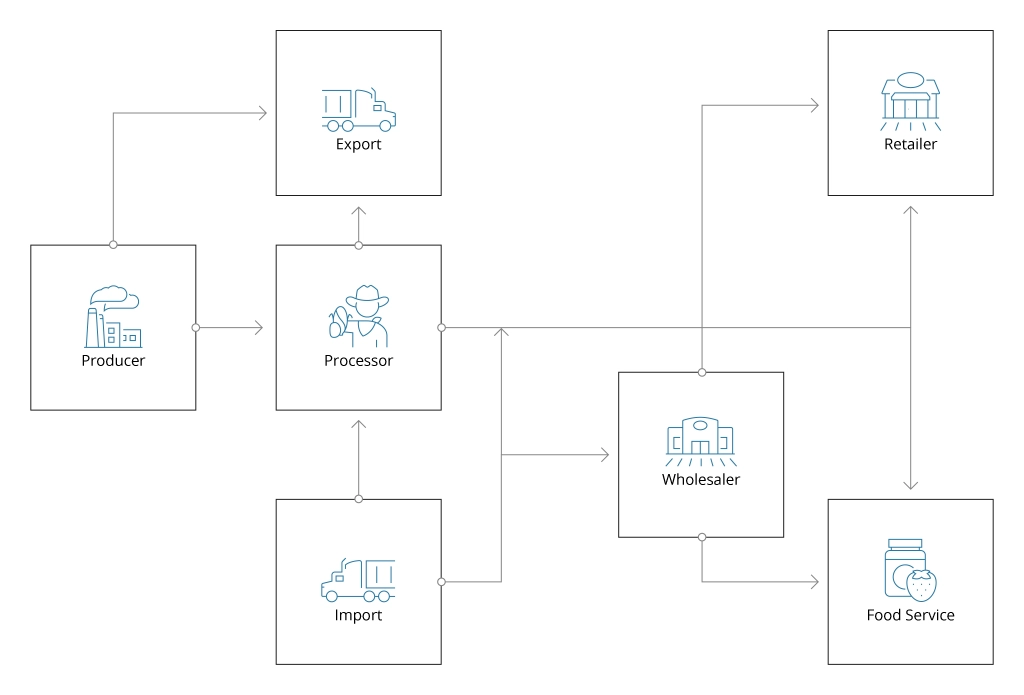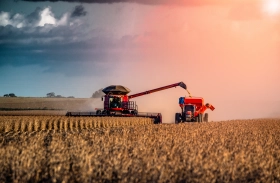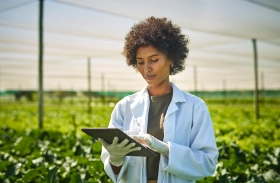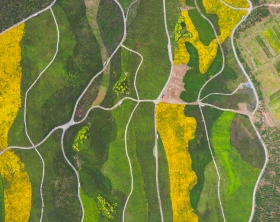Key Agro Challenges Solved by Advanced Data Analytics
The incredible rise of food shortages and natural resource depletion is putting great pressure on farming, providing an impetus for the widespread application of big data analytics in the industry. Coupled with other advanced tech such as IoT, machine learning, and cloud computing, data analytics is indeed set to revamp the way agronomists work and make decisions. How agriculture is using big data, what benefits farmers receive — find detailed answers in this blog post.
Data Analytics for Agriculture: Four Benefits to Watch Out For
Before proceeding to key data analytics applications in farming, let’s reveal the tangible value this technology is able to deliver.
Increased Productivity
Accurate data collection from sensors, IoT devices, GPS-equipped tractors, and its further analysis lends a helpful hand in enhancing key agricultural practices. These include seed management, pesticide usage optimization, yield forecasting, plant disease prediction, and more. With such perks in place, agronomists can boost productivity in their agricultural settings to feed the ever-increasing global population.
Cost Savings
By applying agriculture data analytics, it is possible to optimize resource usage, and this means slashed costs on fertilizers, equipment, spraying, and even workforce numbers. Recent reports also support the idea of big data analytics having the potential to optimize expenditures. For example, a data-driven approach to food provision can not only promote sustainability and reduce waste, but also save as much as $164 billion a year globally.
Sustainability
By sustainability we mean not only resource optimization and waste minimization, but also more sustainable farming practices such as the humane treatment of animals. This includes monitoring livestock welfare status, taking into account parameters like heart rate, body temperature, feeding behavior, movement patterns, as well as environmental conditions — to detect health issues early on, minimize the impact of interventions, optimize living conditions, and promote natural behaviors. Data analytics is also needed here to provide consumers with full visibility into the whole food production lifecycle, including where it comes from, how it is produced, and what the distribution network looks like.
Food Safety
Among other important applications of big data analytics in agriculture is the collection and deep analysis of information about weather, plant conditions, and soil parameters, as well as the quality and usage of chemicals. Such data-fuelled farming significantly lowers the risk of crop failures by preventing crop diseases and enabling proper harvesting procedures.
How Big Data Improves Agriculture: Use Cases
Underpinned by value-rich data gathered by sensors and IoT devices, big data analytics provides deep insights into an array of agricultural aspects. This information is further used to revamp mission-critical workflows, such as yield prediction, chemicals use optimization, equipment maintenance, weather forecasting, and supply chain management.
Yield Prediction
With overconsumption reaching critical levels, crop yield prediction is seen as one of the key applications of big data analytics in agriculture. Namely, by using mathematical models, farmers can analyze important parameters like weather conditions, leaf and biomass index, soil quality, fruit set, and more. The insights delivered power decision-making, including:
- When to plant a crop and which ones are better to use for a particular season and soil type
- What the optimal distance between seeds in a row is and what is the best sowing depth for particular hybrids
- Which type of fertilizers are best suited for given crops, and how much should be applied
- What the risk is of using certain pesticides during different crop development stages
- When exactly is the ideal time to harvest.
By making more informed decisions on all these aspects, agronomists will not only guarantee the best return from their crops — they’ll also enlarge harvest potential for the future, and do so while minimizing operational expenditures.
Predictive Maintenance of Farm Equipment
No matter the sphere, equipment downtime always results in great financial damage. In agriculture, the situation is aggravated by the fact that farmers have specific limitations from equipment makers to repair their machines. In numbers, such restrictions cost $3 billion per year for tractor downtime and $1.2 billion per year for increased labor costs.
With this in mind, predictive maintenance is seen as a safety net. Underpinned by data from sensors and cameras, analytics systems can monitor equipment health in real time to spot deviations from the normal behavior and performance — all to predict failures long before they actually happen. Such advanced tech is also helpful in managing fuel, machine availability, service due dates, and other related aspects, which is important for optimizing equipment operation and ensuring long-term reliability.
Pesticide Usage Optimization
Pesticide pollution has recently become a bigger challenge for farming, considering the fact it affects human health and causes biodiversity loss. For example, there is a global decline in insect populations, which threatens the critical role they play in food production. Moreover, out of the 0.94 Tg net annual pesticide input, 10% remain as residue in soil and 7.2% (70,000 tons) leach into groundwater.
Data analytics for agriculture comes into play here to analyze pesticides application history for every field, detect highly weeded zones for spot spraying, calculate insect development phases, and disease development probability based on the weather data and weather conditions to help administer pesticides use more effectively. Such a sustainable practice eliminates overuse of chemicals, which results in increasing food security, minimizing pesticide side effects on the environment, and enhancing overall profitability.
Weather Conditions Forecast
Constantly changing weather conditions represent one of the biggest challenges for agriculture, because it directly influences overall farming productivity. On top of that, global warming brings even more uncertainties.
Agriculture data analytics is no magic wand that can notably change the state of things, but it is a workable tool that helps deal with environment-related variables. With 24/7 weather monitoring and analysis, agronomists can promptly adjust their field operations planning, while optimizing resource usage during times of trouble.
Automated Data Management
Huge agricultural data volumes generated by sensors, IoT devices, satellites, and drones should be aggregated, unified, and processed. This workflow requires automation efforts from a robust big data system. After that, a deep data analysis is performed, resulting in numerous insights. However, these insights are not decision-ready yet. To bring real value, they must be automatically organized in easy-to-use dashboards, schemes, and reports.
Depending on the workflow, department, and farm size and specialization, these reports should be customized according to particular variables and parameters. Only in such a way can agro businesses make the most of data analytics and revamp their processes.
A case in point: Infopulse built a robust Azure-based data platform to drive precision agriculture for an international food and agro-technical company. By consolidating and analyzing data from numerous distributed systems, the solution enables intelligent automation across 6,000 crop fields, optimizes all key operations, lowers costs, minimizes equipment downtime, and improves decision-making.
Efficiency Enhancement
By making the most of big data analytics in precision agriculture, farmers get an array of benefits, with improved efficiency being the biggest payoff. Better productivity is achieved through:
- Smart irrigation. Fed with sensor-generated data on soil moisture, analytics systems can identify the exact quantity of water needed for a particular area, avoiding resource overuse.
- Crop and field analytics presupposes monitoring plant health in real time to predict diseases and administer optimal doses of pesticides; in turn, this helps ensure high yield quality.
- Greenhouse monitoring is used to analyze lighting levels, temperature, humidity substrate conditions, and gases concentration to take appropriate actions when an alert occurs, thus enhancing overall yield.
- Cattle supervision revolves around monitoring animal health conditions and spotting unusual behavior to detect and prevent the spread of infections.
Supply Chain Management
In agriculture, supply chain management is an immensely wide territory for the application of big data analytics, which covers all the phases of the industry supply chain as it’s shown in the scheme below.

During the production stage, data analytics can gauge the overall performance and reveal issues in the performance of critical equipment. At the fleet management stage, agriculture data analytics comes forward to increase reliability through smart machine tracking and intelligent route optimization. As a result, data-driven supply chain management helps boost efficiency, accelerate time to market, and cut transportation costs.
A case in point: Infopulse helped a large agricultural holding enhance production planning, stock management, and logistics with an advanced ML-based sales forecasting solution. The delivered platform offers an average accuracy of 80%-90% for weekly and monthly forecasts and notably speeds up the time required for forecasting sales from days to just a few minutes.
Conclusion
Agriculture data analytics is perfectly finding its feet in farming settings, and the use cases we have revealed are only part of the whole scope of value it can deliver. Experts in custom software development in agriculture, Infopulse is ready to help you with the most complicated business tasks. Our expertise covers the following areas:
- Data lake and big data development and customization
- Predictive analytics implementation
- IoT software development
- AI and ML services
- Intelligent automation
![Big Data Use Cases in Agriculture [banner]](https://www.infopulse.com/uploads/media/banner-1920x528-key-agro-challenges-solved-by-advanced-data-analytics.webp)




![Generative AI and Power BI [thumbnail]](/uploads/media/thumbnail-280x222-generative-AI-and-Power-BI-a-powerful.webp)
![Data Governance in Healthcare [thumbnail]](/uploads/media/blog-post-data-governance-in-healthcare_280x222.webp)
![AI for Risk Assessment in Insurance [thumbnail]](/uploads/media/aI-enabled-risk-assessment_280x222.webp)
![IoT Energy Management Solutions [thumbnail]](/uploads/media/thumbnail-280x222-iot-energy-management-benefits-use-сases-and-сhallenges.webp)

![Carbon Management Challenges and Solutions [thumbnail]](/uploads/media/thumbnail-280x222-carbon-management-3-challenges-and-solutions-to-prepare-for-a-sustainable-future.webp)

![Automated Machine Data Collection for Manufacturing [Thumbnail]](/uploads/media/thumbnail-280x222-how-to-set-up-automated-machine-data-collection-for-manufacturing.webp)

